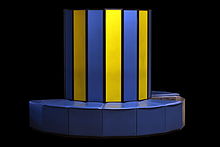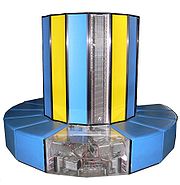- Cray X-MP
-
The Cray X-MP was a supercomputer designed, built and sold by Cray Research. It was announced in 1982 as the "cleaned up" successor to the 1975 Cray-1, and was the world's fastest computer from 1983 to 1985.[citation needed] The principal designer was Steve Chen.
Contents
Description
The X-MP's main improvement over the Cray-1 was that it was a shared-memory parallel vector processor, the first such computer from Cray Research. It housed two CPUs in a mainframe that was near identical in outside appearance, to the Cray-1.
The X-MP CPU had a faster 9.5 nanosecond clock cycle (105 MHz), compared to 12.5 ns for the Cray-1A. It was built from bipolar gate-array integrated circuits containing 16 emitter-coupled logic gates each. The CPU was very similar to the Cray-1 CPU in architecture, but had better memory bandwidth (with two read ports and one write port to the main memory instead of one) and improved chaining support. Each CPU had a theoretical peak performance of 200 MFLOPS, for a peak system performance of 400 MFLOPS.[1]
The X-MP supported 2 or 4 million 64-bit words (16 or 32 MB) of main memory in 16 or 32 banks, respectively. Memory bandwidth was significantly improved over the Cray-1—instead of one port for both reads and writes, there were now two read ports, one write port, and one dedicated to I/O. The main memory was built from 4 Kbit bipolar SRAM ICs.
In 1984, improved models of the X-MP were announced, consisting of one-, two, and four-processor systems. The top-end system was the X-MP/48, which contained four CPUs for a theoretical peak system performance of over 800 MFLOPS.[1] The CPUs in these models introduced vector gather/scatter memory reference instructions to the product line. The amount of main memory supported was increased to a maximum of 16 million words, depending on the model. The main memory was built from bipolar or MOS SRAM ICs, depending on the model.
The system initially ran the proprietary Cray Operating System (COS) and was object-code compatible with the Cray-1. UniCOS (a UNIX System V derivative) ran through a guest operating system facility. UniCOS became the main OS from 1986 onwards. The DOE ran the Cray Time Sharing System OS instead. See the Software section for the Cray 1 for a more detailed elaboration of software (language compiler, assembler, OSes, and applications) as X-MPs and 1s were mostly compatible.
Extended Architecture series
Cray Research announced the X-MP Extended Architecture series in 1986. The EA series CPU had an 8.5 ns clock cycle (117 MHz), and was built from macrocell array and gate array ICs. The EA series extended the width of the A and B registers to 32 bits and performed 32-bit address arithmetic, increasing the amount of memory theoretically addressable to 2 billion words. The largest configuration produced was 64 million words of MOS SRAM in 64 banks. For compatibility with existing software written for the Cray-1 and older X-MP models, 24-bit addressing was also supported. Each EA series CPU's peak performance was 234 MFLOPS. For a four-processor system, the peak performance was 942 MFLOPS.[citation needed]
I/O subsystem
The I/O subsystem could have two to four I/O processors with a total of 2 to 32 disk storage units. The DD-39 and DD-49 hard drives each stored 1.2 GB with 5.9 MB/s and 9.8 MB/s transfer rates, respectively. Optional solid state drives were available with 256, 512 or 1024 MB capacities with transfer rates of 100 to 1,000 MB/s per channel.[1]
Pricing
A 1984 X-MP/48 cost about US$15 million plus the cost of disks. In 1985 Bell Labs purchased a Cray X-MP/24 for $10.5 million along with eight DD-49 1.2 GB drives for an additional $1 million. They received $1.5 million of trade-in credit for their Cray-1.[2]
Image gallery
Successors
The Cray-2, a completely new design, was introduced 1985. A very different compact four-processor design with from 64 MW to 512 MW (512 MB to 4 GB) of main memory, it was specified to 500 MFLOPS but was slower than the X-MP on certain calculations due to its high memory latency.
The X-MP-succeeding Cray Y-MP series was announced in 1988; it also had a new design, replacing the 16-gate ECL gate arrays with a more compact VLSI gate array with larger circuit boards. It was a major improvement of the X-MP supporting up to eight processors.
In popular culture
- The parallel-processor nature of the X-MP and its ability to solve multi-variate simultaneous equations rapidly receives honourable mention in Tom Clancy's novel, The Hunt for Red October, when 'Skip' Tyler uses the USAP's X-MP machine to work out the performance and sonic characteristics of the October for Jack Ryan on behalf of the CIA in return for both profit and the chance to evaluate the vessel should it be successfully gained either temporarily or better yet permanently.
- The film Tron, a Cray X-MP can be briefly seen in the foreground in the scene with Flynn & Lori en-route to her work station. Also the Cray X-MP is cited in the ending credits of the film as "Supercomputer".
- The film The Last Starfighter depended heavily on high polygon count (for the time) models with complex lighting effects, the rendering of which was made possible by the use of the X-MP.[3]
- In Michael Crichton's novel Jurassic Park, three Cray X-MPs provide the park's computing power.
- In Jurassic Park: Trespasser, a Cray X-MP is featured as the supercomputer supporting Site B.
- In M. Ann Jacoby's novel Life after Genius, the main character uses the X-MP at Bell Labs in New Jersey to calculate 1.5 billion zeros of the Riemann zeta-function.
- The Cray X-MP was used for one of the first Pixar short films, "The Adventures of André and Wally B.", in 1984. Special thanks is given to Cray Research in the short's credits for use of the machine.
Further reading
- Keith Robbins and S. Robbins (1989) Lecture Notes in Computer Science: The Cray X-MP/Model 24 Springer ISBN 3-540-97089-4
References
- ^ a b c Cray Research, Inc. (1985). "The Cray X-MP Series of Computer Systems".
- ^ Dennis Ritchie (2000-09). "Two Cray X/MP papers". http://cm.bell-labs.com/cm/cs/who/dmr/cray.html. Retrieved 2009-04-02.
- ^ Ohio State University CG history page
Cray Research
Cray-1 • Cray X-MP • Cray-2 • Cray Y-MP • Cray XMS • Cray Y-MP EL
Cray C90 • Cray EL90 • Cray T3D • Cray J90 • Cray T90 • Cray T3E • Cray SV1
Cray Computer Corp.
Cray-3 • Cray-4
Cray Research Superservers
Cray APP • Cray S-MP • Cray CS6400
Cray Inc.
Cray SX-6 • Cray MTA-2 • Cray Red Storm • Cray X1 • Cray XT3 • Cray XD1
Cray XT4 • Cray XMT • Cray XT5 • Cray CX1 • Cray XT6 • Cray XE6 • Cray CX1000 • Cray XK6Categories:- 1982 introductions
- Supercomputers
Wikimedia Foundation. 2010.






